
Samsung's new smart LED TV, the ES8000, will begin shipping today, the company announced at a press conference. We got some hands-on time with the TV and a new touch remote, and while we're sold on some of the layout and control schemes as the new way forward, the ES8000 seems to be lacking a bit in polish.
The ES8000 was initially announced at CES in January, though Samsung did not offer demos of the "smart" portions of the TV at the time. With a dual-core processor and a few hundred gigabytes of storage, the TV is as close to a computer as any smartphone or tablet, though how it's used leaves some interaction problems to solve—that is, touch can't come into play.
The ES8000's home screen (called "Smart Hub" by the TV) is a jumble of icons, though it shows the TV will integrate some important applications, like Hulu, Netflix, Pandora, Twitter, and Facebook. While on the home screen, the TV displayed a small live stream of a cable channel in the top left corner; if selected, the stream would be pulled into full-screen mode.
Voice control and gestures play a large role in controlling the new TV. In addition to a camera and built-in microphone, the touch remote that comes with the TV also has a built-in mic that users can speak into when the environment is too loud (as may often be the case when a TV is playing in the background, though the TV has a second built-in mic for noise canceling).
Unlike the Kinect, though, the camera can only be adjusted up and down via a mechanical wheel on the back of the TV, and not side to side; if your living room setup doesn't point the TV right at where you sit, you might be out of luck.


The TV can be woken up either through voice ("Hi, TV!" as demonstrated in a few commercials) or a wave of the hand, similar to Microsoft's Kinect. The TV requires personal profiles to operate, which users can unlock through facial recognition on the TV's camera or though a standard text entry login.
A Samsung representative demonstrated some of the functionality of the ES8000 to us in a sound-proofed room. He pulled up the TV's Web browser, which displayed a standard URL field above Google's search page and a keyboard on one side of the screen. The rep held up the remote microphone to his mouth. "Basketball scores," he said. About ten seconds passed, and nothing happened. He tried again: "basketball scores." A couple of seconds later, "Basketball scores basketball scores" appeared in the search field. A second search happened a bit more quickly, though the TV still took time to think through the commands.
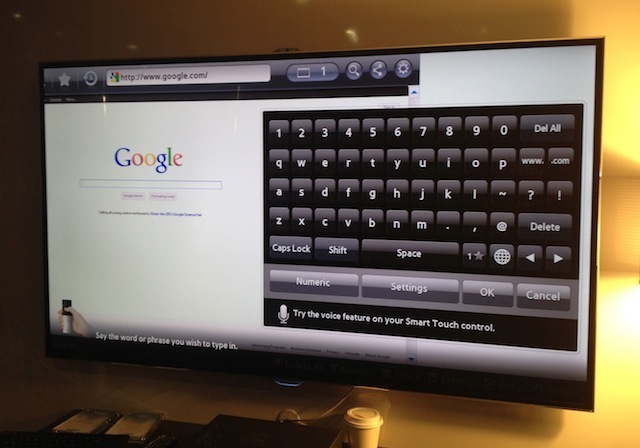

The TV provides a set of keyboard keys onscreen, and users can enter text by pointing their hand or the remote at the screen, letter by letter. Presumably, this is for when the TV can't or won't understand the things you're speaking, but is barely less unwieldy than having to scroll around and peck out letters with the directional keys on a standard remote control. Samsung does plan to sell a special keyboard with attached touchpad that should make text entry less of a pain, but it will retail for $99 as a separate accessory. At the event, reps noted that the TV can also be controlled with Samsung smartphones and tablets to move the cursor and type in text, but this functionality wasn't set up for demonstration.
Like the voice control, the motion of the cursor under gesture control was a little stuttery and unsure, though its movement is smoother than on the Kinect or with a Wiimote, which have cursors with a tendency to swing and yo-yo around the screen as if connected to a bungee cord. On an XBox or Wii the cursors are also prone to jittering around when you're holding your hand still, inviting anxiety that you'll move off your selection before the device will register it. The cursor on the ES8000 rested much better when a selection was intended, even though the hand selecting it was not perfectly still.
When something is selected and displayed full screen on the TV, users can pull up an options menu that displays a bundle of random navigation jump choices, including Fitness Home, Kids Home, Skype, Samsung Apps, and Current Time. This menu can also be used to page the channel up or down, turn the volume up and down, or change the source port.

Because Samsung may not expect users to be able to fully embrace touch and voice controls right away, it includes the touch remote mentioned earlier. The remote has a spare touch area surrounded by a few standard buttons, like channel up/down (again) and volume up/down. The touchpad worked well, and can be used to enter text and scroll the cursor around the screen. Pushing the buttons was difficult as they had little tactile feedback, making us wish for tap-to-select, but we don't expect it on a remote, since it will be often handled carelessly on a couch. As for the button selection, the channel up/down button seems wildly out of place on a TV like this; paging through channels sequentially just to see what's on seems like an antiquated action to include in such a modern device.
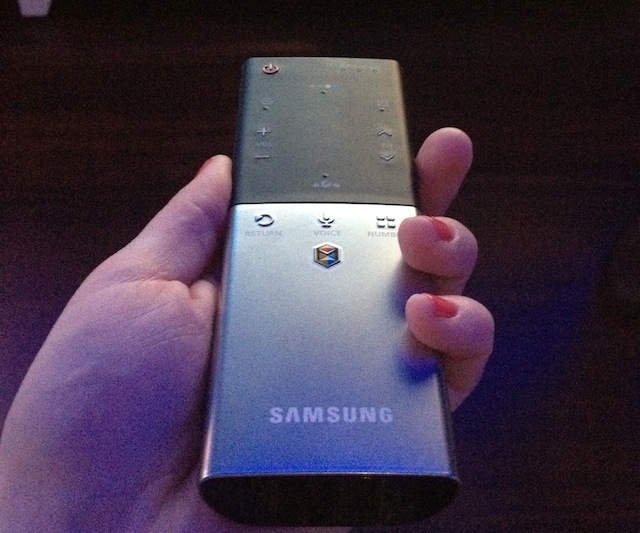
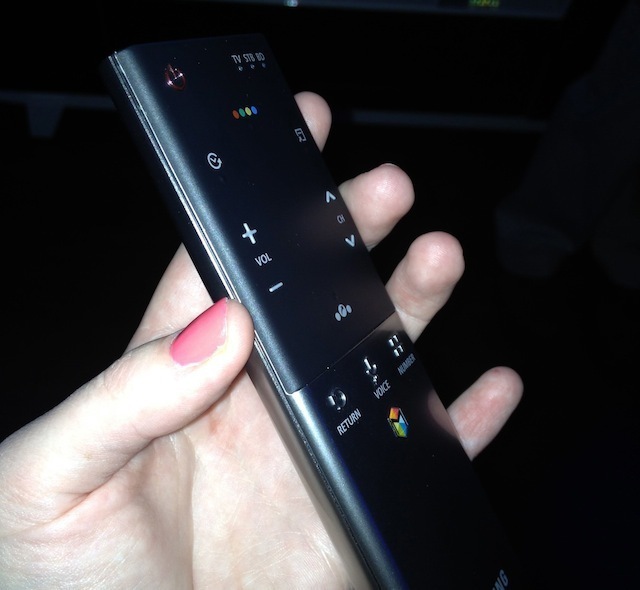
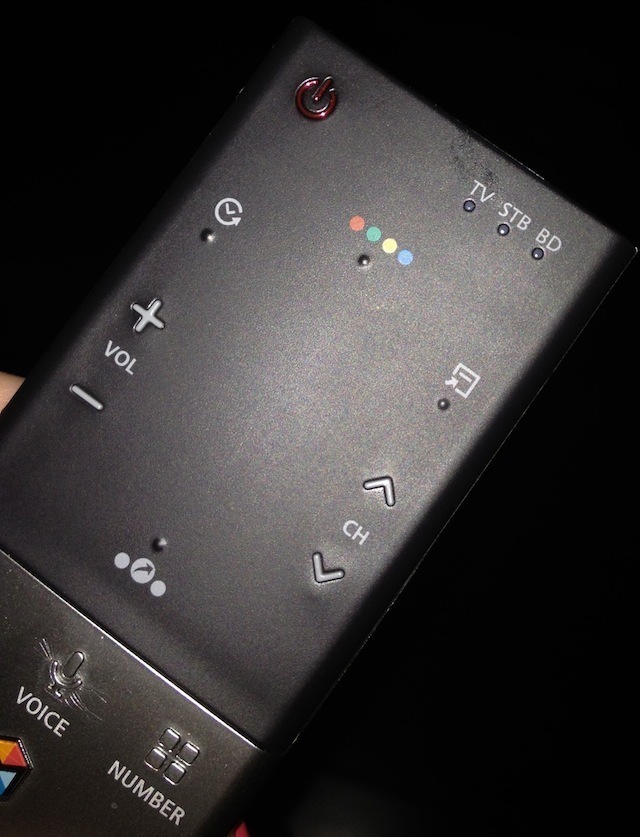
The ES8000 had one more minor feature, called an IR blaster. The IR blaster is a separate little tower that sits next to the TV and, without any wires connected to it from any device, can relay instructions from other IR devices surrounding the TV. For example, the cable set top box shown in the photos could be controlled with its own remote and have its content displayed on the TV, despite the fact that it was not wired to the TV or the IR blaster; everything worked wirelessly. The system would have been much more elegant if the IR blaster could have been built into the TV instead of requiring a squat little tower standing alone underneath it, but to be able to control older devices to the TV without wires is a nice feature nonetheless.
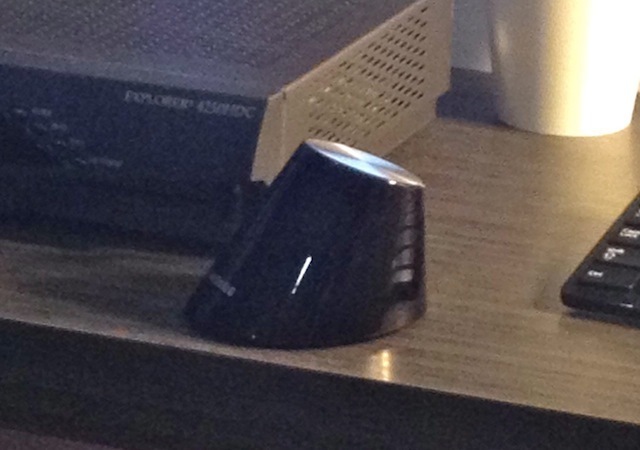
Altogether, what's meant to be special about this TV reads like a list of inputs: there are buttons, voice, gestures, touchpads, and keyboards. In practical use, we wonder if users won't get a little lost. Even though the TV is shipping now (technically, within the next couple of weeks, according to another representative we spoke to), Samsung wouldn't tell us either the price or exact release date.
Update: Samsung has specified prices for the ES8000: $2,999.99 for the 46-inch model, $3,479.99 for the 55-inch, $4,399.99 for the 60-inch, and $5,099.99 for the 65-inch. All will be available this month except the 65-inch, which is noted only as "to be announced."
reader comments
43